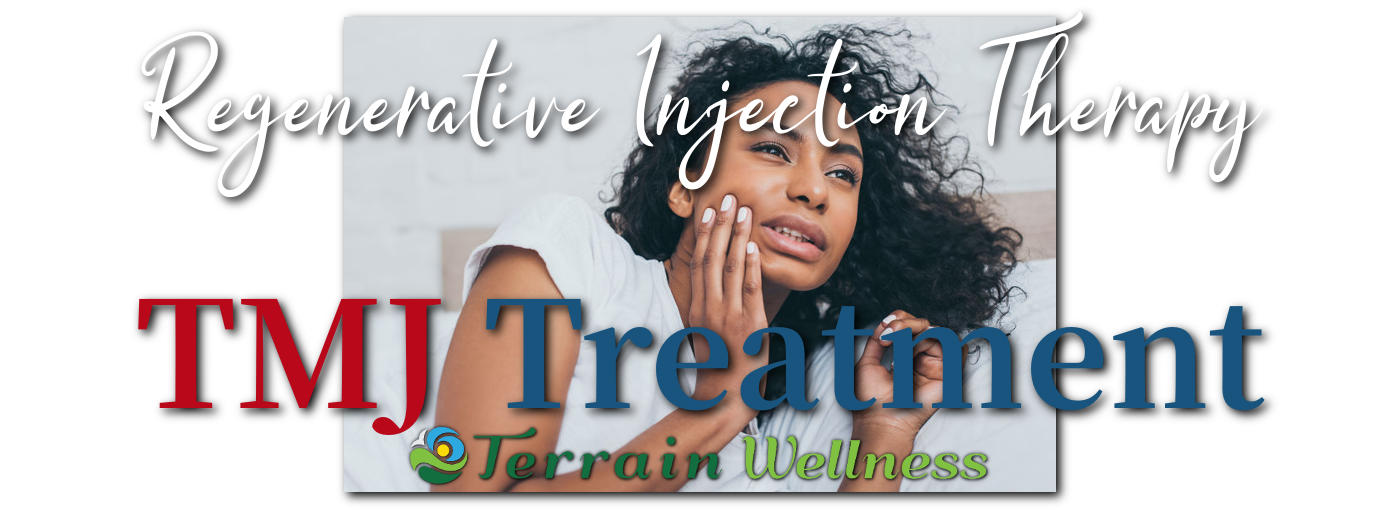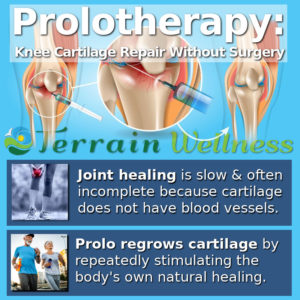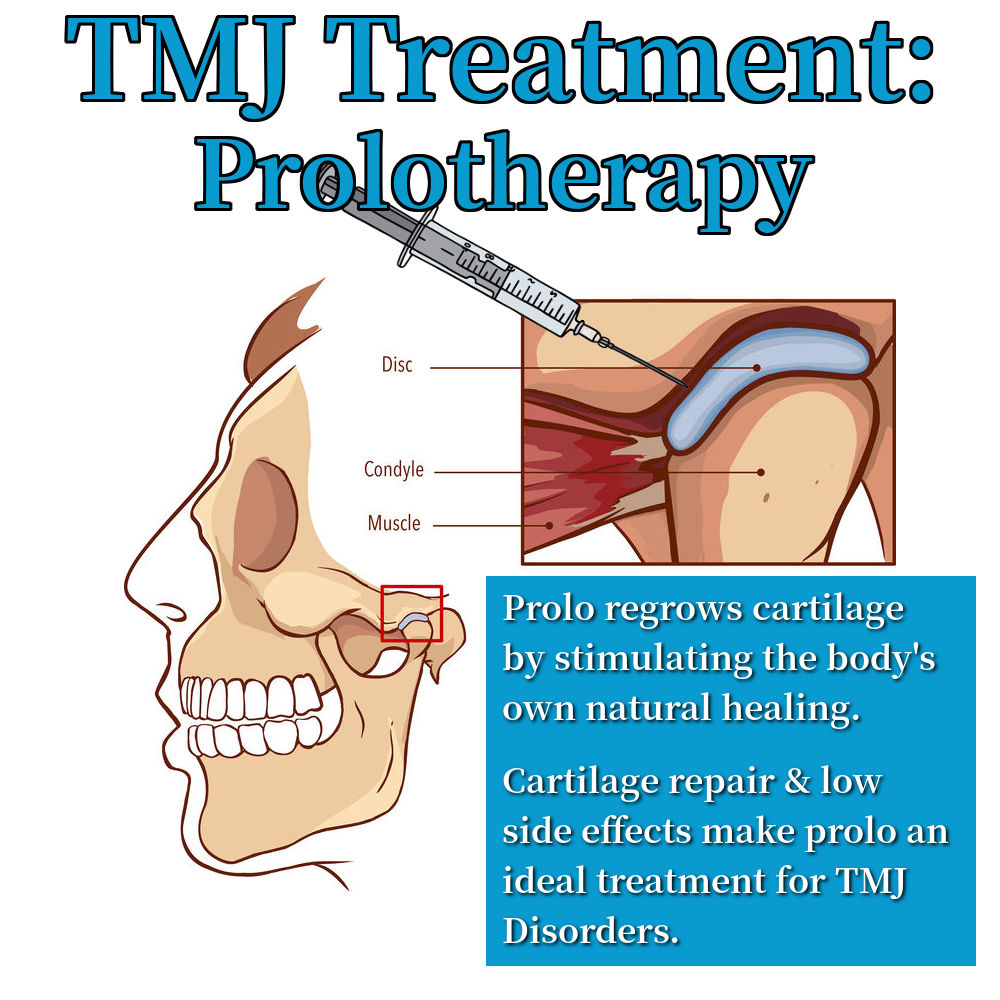TMJ Treatment

Pain, discomfort, popping or clicking associated with moving the mouth for speaking or chewing is commonly referred to as TMJ. TMJ is an acronym referring to the Temporo-Mandibular Joint that allows for both hinge-like and sliding movements in the jaw. Technically, the TMJ acronym simply refers to the joint itself, not the painful conditions associated with it. A more concise term is TMD (TemporoMandibular Disorders), which covers a variety of ailments related to the jaw joint and the muscles that surround it. But don’t worry, if you come into our clinic needing help for TMJ, we know what you mean.
While treatments range from exercises, acupuncture, wearable medical devices and even surgery, research shows excellent results for treating TMJ pain using a regenerative injection technique called prolotherapy. Less invasive treatments such as acupuncture or a wearable device like a Night Guard definitely help many people resolve their TMJ pain, but there are also cases where these measures don’t go far enough. While there are many treatment options for TMD, this article will focus on regenerative injection therapy.
Before we delve further into using prolo for TMJ disorders, it’s worth noting that I, Dr. Danielle Lockwood, did my undergraduate at USC Dental and worked as a dental hygienist while in medical school. This background of working in the dental field gives me a unique understanding of TMJ disorders that most doctors would not bring to the table. Yes, all doctors learn about TMD in medical school, but working as a hygienist in numerous busy dental clinics and performing countless dental injections as a routine part of my work there adds nuance to my perspective on issues related to the mouth and jaw. Not only that, but in addition to being a primary care physician, I’m also a licensed acupuncturist. The acupuncture system entails using needles at specific trigger points to affect the way that nerves signal muscles to contract and also how pain signals are sent back to the brain. Having both dental and acupuncture experience makes me particularly well-suited to perform prolotherapy, most especially for treating TMJ pain.
What is Prolotherapy?

Prolotherapy, or prolo for short, refers to an injection therapy process where a liquid suspension of a pain reliever mixed with a “proliferant agent” is injected into the soft tissues in or around a joint with a view to stimulating the body’s natural healing processes beyond normal. The proliferant agent is a non-toxic substance (often a dextrose solution) that is natural to the body, but that signals the body to repair itself. The way prolo works to repair joint tissue is both complex, yet elegantly simple, let me explain. When the body is injured, cells within the body are ruptured and spill their contents out into the interstitial tissue of the body.
Bruising or swelling when you get hurt are examples of this spilling out of ruptured cells. Here’s where things get interesting: the spilled contents of these cells actually signals the body’s healing and immune response. The initial swelling and the presence of spilled cell contents floating around in the space between cells is a clear signal that the body needs to repair itself. White blood cells, growth factors and other body resources flood to the area to repair tissue and body structures, control infection and ensure long-term healing.
SIDE NOTE: Because this swelling process is part of the body’s healing response, drugs/treatments designed to reduce swelling or inflammation can be harmful to joint health over time because they interrupt the healing process.
Let’s recap: cells break open and spill their contents out into the interstitial space between cells when you get hurt, resulting in swelling/bruising. The contents of ruptured cells in the interstitial space between cells in turn stimulates the healing and immune responses. But, what does this have to do with prolo? The answer is that the “proliferant agent” that we inject during prolotherapy simulates the spilled cell contents present during an injury without doing any real damage. When the body senses the proliferant agent, it signals the body to repair itself even though no real injury has occurred.
The stimulation of repair seen with prolotherapy is especially useful for joint, cartilage and connective tissue because these body tissues are avascular. Avascular means that these body structures don’t have blood vessels in them. Because avascular tissue doesn’t get direct blood flow, their ability to heal quickly is limited. In contrast, some body tissues like muscles, are highly vascular. Vascular body tissues like muscles heal quickly, while avascular tissues like cartilage and joints heal very slowly. Because joints and cartilage are avascular and heal slowly, it’s common to see injured joints that don’t heal properly. Prolo is very useful because it can stimulate joint healing in cases where repeated stresses on the joint or anti-inflammatory medications have interrupted the joint repair process.
Prolotherapy For TMJ Disorders

Prolo is uniquely useful for resolving painful joint and connective tissue because it works by stimulating the body’s own healing response. While prolo has long been associated with regenerating cartilage in knee, hip and shoulder joints, research has also shown excellent results for treating TMJ pain. In a recent research study on using Prolotherapy to treat TMJ hypermobility disorders, doctors were able to achieve a success-rate of 91% along with zero long-term complications from treatment. About a third of patients in the study were able to resolve their TMJ disorder in a single injection session, while the remainder needed two to three sessions.
At times, there are patients whose TMJ pain may be related to neck and shoulder pain or muscle tension. In these cases, be sure to talk with us at your treatment consult because we can also use prolo or related injection techniques to help alleviate some of that tension as well.
Because prolo works by stimulating the body’s own natural healing response, side effects are minimal and are generally limited to the temporary discomfort experienced when getting any injection. Because of prolo’s long history and low risk of side effects, we prefer it as a treatment modality for treating many painful joint and connective tissue conditions including those of TMJ disorders.
Conclusions:
Prolotherapy is a revolutionary treatment modality that works by stimulating the body’s own healing responses to repair itself. This ability to stimulate natural tissue repair is especially useful in joint and connective tissue because these body structures avascular and thus heal very slowly due to a limited supply of nutrients. While prolo has long been used successfully in knee, shoulder and hip joints, more recent research has shown excellent results using regerative injection therapy for treating TMD/TMJ Disorders.
Because prolo has demonstrated strong benefits, a high success rate and little risk of side effects, I do administer it in the course of my clinical practice. My background as an undergraduate in a dental program and previous work in dental hygiene gives me a unique perspective in using regenerative injection therapy to treat TMJ Disorders.
I hope this article was helpful for you. Thanks for reading.
